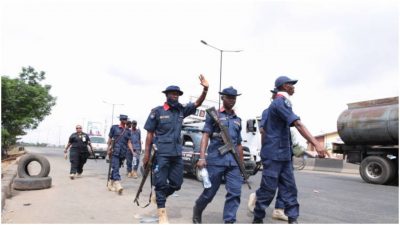Eight days ago, precisely on Thursday February 22, 2024, President of the Russian Federation, Vladimir Putin, flew on a modernised Tu-160M nuclear-capable strategic bomber, in a move likely to be seen in the West as a pointed reminder of Moscow’s nuclear capabilities.
The giant swing-wing plane, codenamed “Blackjacks” by military alliance NATO, according to Reuters, is a modernised version of a Cold War-era bomber that the former Soviet Union would have deployed in the event of nuclear war to deliver weapons at long distances.
State TV showed Putin clambering down a ladder from the plane after the flight and telling reporters it was a reliable and modernised aircraft that could be accepted by the Russian Air Force.
“It’s a new machine, a lot about it is new. It’s easier to control. It’s reliable,” said Putin.
The Russian leader, who is expected to easily win another six-year term next month, made the flight at a time when Moscow and the West are at odds over Russia’s war in Ukraine and the death in prison of opposition politician Alexei Navalny.
Some Russian and U.S. diplomats say they do not remember a time of worse relations between the world’s two biggest nuclear powers, including during the 1962 Cuban Missile Crisis.
State TV showed the giant plane, which Russia nicknames “White Swans”, taking off and landing at a runway belonging to the factory in Kazan that makes the modernised supersonic aircraft, with correspondent Pavel Zarubin excitedly calling it “a unique event”.
Kremlin spokesman Dmitry Peskov said the plane’s flight path was a military secret.
The flight with Putin aboard had lasted 30 minutes, Russian news agencies reported.
The Tu-160M, which has a crew of four, is capable of carrying 12 cruise missiles or 12 short-range nuclear missiles and can fly 12,000 km (7,500 miles) non—stop without refuelling.
Russia’s nuclear doctrine sets out the conditions under which a Russian president would consider using a nuclear weapon: broadly as a response to an attack using nuclear or other weapons of mass destruction, or to the use of conventional weapons against Russia “when the very existence of the state is put under threat”.
Former President Dmitry Medvedev, now deputy chairman of Russia’s Security Council, has repeatedly warned of the risk of a nuclear conflict with the West since Moscow sent tens of thousands of troops into Ukraine in 2022.
But Putin, who is commander-in-chief of Russia’s armed forces, said in October that the existence of the Russian state was not under threat and that “no person of sound mind and clear memory would think of using nuclear weapons against Russia”.
Putin, 71, flew in an older version of the Tu-160 aircraft in 2005 during a training exercise.
Under a contract signed in 2018, 10 of the modernised Tu-160M nuclear bombers are meant to be delivered to the Russian Air Force up to 2027 at a cost of 15 billion roubles ($163 million) each.
Tupolev, the plane’s manufacturer, says the modernised version was 60% more effective than the older version with significant improvements to its weaponry, navigation and avionics. ($1 = 92.0330 roubles)




